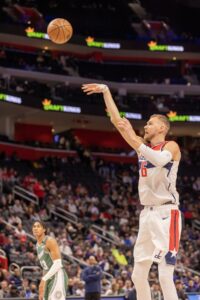When NBA teams are in the process of filling out their training camp rosters, the most common form of deal signed by players around the league is the Exhibit 10 contract. An Exhibit 10 contract can be converted into a two-way deal or puts a player in line to earn a bonus if he’s waived and then joins his team’s G League affiliate.
Many of those non-guaranteed training camps also include an Exhibit 9 clause in addition to – or in place of – Exhibit 10 language.
An Exhibit 9 clause protects an NBA team in the event that a player suffers a significant injury in training camp.
If a player on a standard non-guaranteed contract without an Exhibit 9 clause suffered such an injury, his club would be required to pay him his salary until he’s healthy enough to play or until the end of that season, whichever comes first. For example, a player on a non-guaranteed rookie minimum deal who sustained a season-ending ACL tear would be owed his full $1,119,563 salary.
If the injured player’s contract includes Exhibit 9 language, however, his team could waive him and only be on the hook for a one-time payment of $15K. That amount has increased from $6K in the NBA’s previous Collective Bargaining Agreement.
An Exhibit 9 contract, which is non-guaranteed and doesn’t count against the salary cap until the start of the regular season, can only be a one-year, minimum-salary deal. A team can carry up to six players on Exhibit 9 deals, but can’t sign a player to such a contract unless it has at least 14 players already under contract (not including two-way deals).
In most cases, if a team plans to have a player on a non-guaranteed contract participate in training camp and/or the preseason, his contract will include an Exhibit 9 clause in order to limit the club’s liability.
Earlier this offseason, for example, the Rockets wanted to begin signing their training camp invitees, but only had 13 players on standard contracts. Houston signed Joshua Obiesie to an Exhibit 10 pact, making him their 14th man and meeting the roster minimum required to begin completing Exhibit 9 deals. Because the Rockets don’t have injury protection for Obiesie, they reportedly have no intention of having him take part in camp.
The Heat took a similar approach, signing Brandon McCoy as their 14th man to an Exhibit 10 contract that didn’t include an Exhibit 9 clause. With 14 players on standard contracts, Miami subsequently signed several players to Exhibit 9 deals, waiving McCoy in the process — he won’t be on the Heat’s camp roster.
An Exhibit 9 contract that also includes Exhibit 10 language can be converted into a two-way deal. In that scenario, the Exhibit 9 clause would become null and void, so the team would no longer have injury protection.
In the event that a player with Exhibit 9 language in his contract makes his team’s regular season roster, his deal would be converted to a standard non-guaranteed contract. The Exhibit 9 protection wouldn’t carry over into the regular season.
Note: This is a Hoops Rumors Glossary entry. Our glossary posts will explain specific rules relating to trades, free agency, or other aspects of the NBA’s Collective Bargaining Agreement. Larry Coon’s Salary Cap FAQ was used in the creation of this post.
An earlier version of this article was published in 2014.
 According to the Celtics (
According to the Celtics (